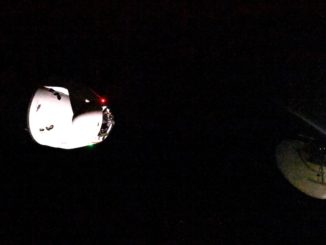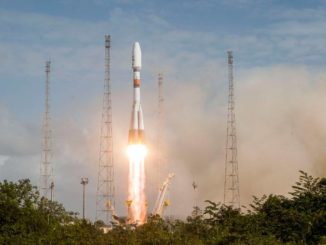
The 100th flight of a Falcon 9 rocket delivered 60 satellites to orbit for SpaceX’s Starlink network Tuesday night, adding another building block to a planned fleet of thousands of solar-powered space-based relay stations to beam broadband connectivity around the world.
The successful mission late Tuesday also set a new record for SpaceX’s rocket reuse program — one that could be broken again within months if SpaceX maintains its feverish launch cadence. For the first time, a reusable Falcon 9 booster completed its seventh trip to space and back on Tuesday night’s flight.
The Falcon 9 rocket fired its nine kerosene-fueled Merlin 1D engines and roared off pad 40 at Cape Canaveral Air force Station at 9:13:12 p.m. EST Tuesday (0213:12 GMT Wednesday). The 229-foot-tall (70-meter) launcher darted through a broken cloud layer over the pad and rocketed toward the northeast from Cape Canaveral to line up with the mission’s targeted orbital plane within the Starlink network.
The rocket’s 15-story first stage booster dropped away from the Falcon 9 upper stage about two-and-a-half after liftoff, setting a course for a controlled touchdown on SpaceX’s drone ship “Of Course I Still Love You” positioned several hundred miles northeast of Cape Canaveral in the Atlantic Ocean,
The booster — designated B1049 in SpaceX’s rocket inventory — reignited its center engine for a braking maneuver just before touchdown, then extended a landing gear before settling onto the deck of the drone ship. The apparently flawless landing punctuated the seventh mission of the B1049 vehicle, making it SpaceX’s “fleet leader.”
Elon Musk, SpaceX’s founder and CEO, has said the newest version of the Falcon 9 booster could fly 10 times without any major refurbishment, and perhaps 100 times with periodic overhauls.
Flying some 140 miles over the North Atlantic, 60 new Starlink internet satellites have deployed from the upper stage of SpaceX’s Falcon 9 rocket.
This brings the total number of Starlinks launched since May 2019 to 955.https://t.co/5fFiWvJxb4 pic.twitter.com/f2DHahj1j1
— Spaceflight Now (@SpaceflightNow) November 25, 2020
Along with its reused first stage booster, the Falcon 9 launched with a recycled clamshell-like payload shroud, half of which flew on two previous missions. The other half of the fairing was a veteran one prior launch.
Two recovery vessels were dispatched to sea to retrieve the fairing halves from Tuesday night’s mission after they parachuted back to Earth from space.
While the booster and fairing shells descended back to Earth, the Falcon 9’s upper stage guided the 60 flat-panel Starlink satellites into a transfer orbit inclined 53 degrees to the equator. Around 15 minutes after liftoff, the upper stage released retention rods to allow the stack of 60 spacecraft to fly free from the rocket over the North Atlantic Ocean.
The Falcon 9 aimed to place the satellites into an elliptical orbit ranging between 132 miles (213 kilometers) and 227 miles (366 kilometers). A member of SpaceX’s launch team confirmed on a mission audio loop that the rocket achieved an on-target orbital insertion.
The launch was previously scheduled Saturday night, then delayed to Sunday, when SpaceX called off a launch attempt due to concerns about “mission assurance.” SpaceX bypassed a launch opportunity Monday due to a forecast of poor conditions in the Falcon 9 booster’s offshore landing zone, setting the stage for Tuesday’s countdown.
Tuesday night’s launch was the 23rd SpaceX mission of 2020, extending the company’s record cadence of flights. The previous record for the most SpaceX launches in a year was 21 missions in 2018.

The quarter-ton Starlink satellites, built by SpaceX in Redmond, Washington, were expected to unfurl power-generating solar arrays and prime their krypton ion thrusters to begin raising their orbits to an operational altitude of 341 miles (550 kilometers), where they will join more than 800 other Starlink relay stations to beam broadband internet signals across most of the populated world.
With the launch Sunday, SpaceX has deployed 955 Starlink satellites into orbit.
SpaceX plans to operate an initial block of around 1,500 Starlink satellites in orbits 341 miles above Earth. The company, founded by billionaire Elon Musk, has regulatory approval from the Federal Communications Commission to eventually field a fleet of up to 12,000 small Starlink broadband stations operating in Ku-band, Ka-band, and V-band frequencies.
There are also preliminary plans for an even larger fleet of 30,000 additional Starlink satellites, but a network of that size has not been authorized by the FCC.
Flying some 140 miles over the North Atlantic, 60 new Starlink internet satellites have deployed from the upper stage of SpaceX’s Falcon 9 rocket.
This brings the total number of Starlinks launched since May 2019 to 955.https://t.co/5fFiWvJxb4 pic.twitter.com/f2DHahj1j1
— Spaceflight Now (@SpaceflightNow) November 25, 2020
SpaceX says the Starlink network — designed for low-latency internet service — has entered a beta testing phase in multiple U.S. states and Canada.
“Last month, SpaceX launched its “Better Than Nothing Beta” test program,” the company said in a post on its website. “Service invites were sent to a portion of those who requested availability updates on Starlink.com and who live in serviceable areas. A couple weeks ago, Canada granted Starlink regulatory approval and last week SpaceX rolled out the service to parts of parts of southern Canada.”
The “invitation-only” beta testing program is focused on testing Starlink connectivity in rural and remote areas in the northern United States and southern Canada, said Kate Tice, a SpaceX engineer who co-hosted the company’s launch webcast Tuesday night.
“As we launch more satellites, install more ground stations, and improve our networking software, data speed, latency, and uptime will all improve dramatically,” Tice said.
SpaceX projects latency on the Starlink network will fall to around 16 to 19 milliseconds by mid-2019, Tice said.
“At our current pace, we expect to expand our beta in a notable way very early next year, in the late January-February timeframe,” she said.
Email the author.
Follow Stephen Clark on Twitter: @StephenClark1.



